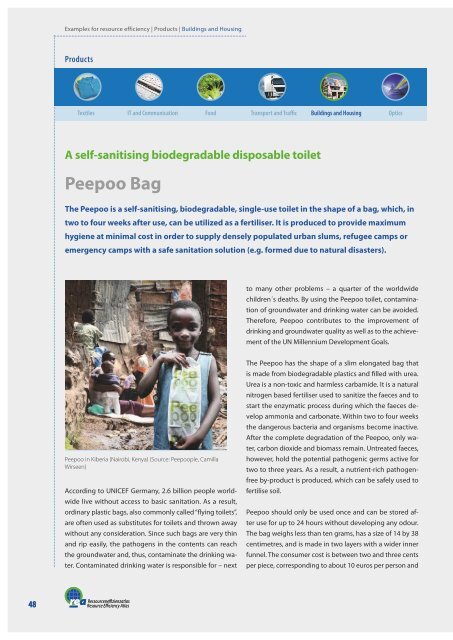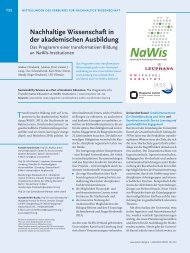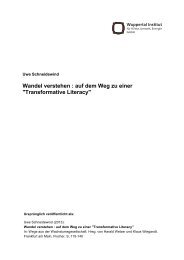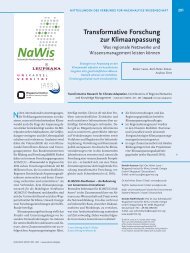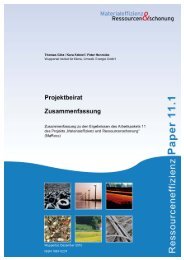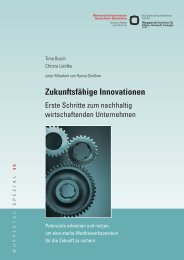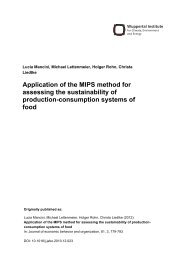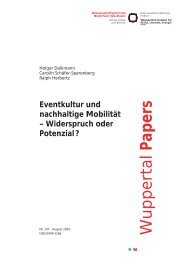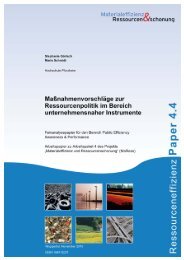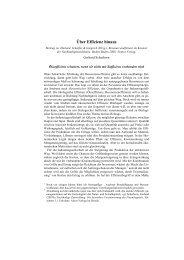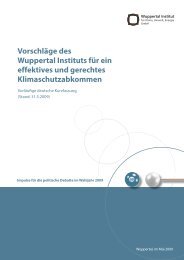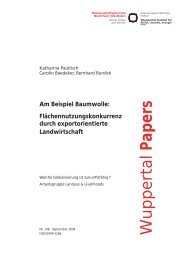Resource Efficiency Atlas - Publication Server of the Wuppertal ...
Resource Efficiency Atlas - Publication Server of the Wuppertal ...
Resource Efficiency Atlas - Publication Server of the Wuppertal ...
You also want an ePaper? Increase the reach of your titles
YUMPU automatically turns print PDFs into web optimized ePapers that Google loves.
48<br />
Examples for resource efficiency | Products | Buildings and Housing<br />
Products<br />
Textiles IT and Communication Food Transport and Traffic Buildings and Housing Optics<br />
A self-sanitising biodegradable disposable toilet<br />
Peepoo Bag<br />
The Peepoo is a self-sanitising, biodegradable, single-use toilet in <strong>the</strong> shape <strong>of</strong> a bag, which, in<br />
two to four weeks after use, can be utilized as a fertiliser. It is produced to provide maximum<br />
hygiene at minimal cost in order to supply densely populated urban slums, refugee camps or<br />
emergency camps with a safe sanitation solution (e.g. formed due to natural disasters).<br />
Peepoo in Kiberia (Nairobi, Kenya) (Source: Peepoople, Camilla<br />
Wirseen)<br />
According to UNICEF Germany, 2.6 billion people worldwide<br />
live without access to basic sanitation. As a result,<br />
ordinary plastic bags, also commonly called “flying toilets”,<br />
are <strong>of</strong>ten used as substitutes for toilets and thrown away<br />
without any consideration. Since such bags are very thin<br />
and rip easily, <strong>the</strong> pathogens in <strong>the</strong> contents can reach<br />
<strong>the</strong> groundwater and, thus, contaminate <strong>the</strong> drinking water.<br />
Contaminated drinking water is responsible for – next<br />
Ressourceneffizienzatlas<br />
<strong>Resource</strong> <strong>Efficiency</strong> <strong>Atlas</strong><br />
to many o<strong>the</strong>r problems – a quarter <strong>of</strong> <strong>the</strong> worldwide<br />
children´s deaths. By using <strong>the</strong> Peepoo toilet, contamination<br />
<strong>of</strong> groundwater and drinking water can be avoided.<br />
Therefore, Peepoo contributes to <strong>the</strong> improvement <strong>of</strong><br />
drinking and groundwater quality as well as to <strong>the</strong> achievement<br />
<strong>of</strong> <strong>the</strong> UN Millennium Development Goals.<br />
The Peepoo has <strong>the</strong> shape <strong>of</strong> a slim elongated bag that<br />
is made from biodegradable plastics and filled with urea.<br />
Urea is a non-toxic and harmless carbamide. It is a natural<br />
nitrogen based fertiliser used to sanitize <strong>the</strong> faeces and to<br />
start <strong>the</strong> enzymatic process during which <strong>the</strong> faeces develop<br />
ammonia and carbonate. Within two to four weeks<br />
<strong>the</strong> dangerous bacteria and organisms become inactive.<br />
After <strong>the</strong> complete degradation <strong>of</strong> <strong>the</strong> Peepoo, only water,<br />
carbon dioxide and biomass remain. Untreated faeces,<br />
however, hold <strong>the</strong> potential pathogenic germs active for<br />
two to three years. As a result, a nutrient-rich pathogenfree<br />
by-product is produced, which can be safely used to<br />
fertilise soil.<br />
Peepoo should only be used once and can be stored after<br />
use for up to 24 hours without developing any odour.<br />
The bag weighs less than ten grams, has a size <strong>of</strong> 14 by 38<br />
centimetres, and is made in two layers with a wider inner<br />
funnel. The consumer cost is between two and three cents<br />
per piece, corresponding to about 10 euros per person and


